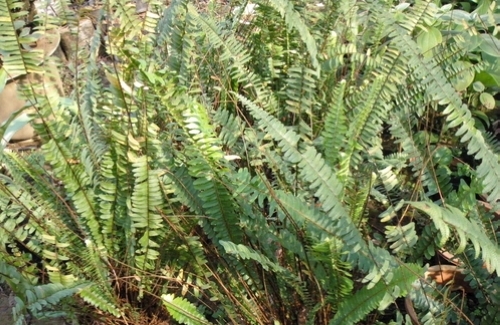Nephrolepis cordifolia, or Fishbone Fern, is a fern of wide distribution. It has bright green fronds that are from 16-32 inches (40-80 cm) long and about 4 inches (10 cm) wide at their widest point. It is a vigorous grower and colony former, producing small scaly tubers on their roots. In nature, they will grow in a wide variety of situations, growing in the soil or among rocks as well as growing as an epiphyte. They are an excellent fern for pots or baskets and will grow in the garden. They should be treated as an annual in USDA zone 7 (and below).
Culture: Nephrolepis cordifolia will grow in shade to full sunlight and prefers a well-drained soil mix. In the greenhouse, we use a soil mix consisting of 2 parts peat moss to 1 part loam to 1 part sand or perlite. Although they are very drought tolerant, we keep them moist for optimum growth. They are fertilized on a weekly basis during the growing season with a balanced fertilizer diluted to ½ the strength recommended on the label. Nephrolepis cordifolia plants are very vigorous growers and should be re-potted on a yearly basis. During the winter months, water should be somewhat restricted and fertilizer applications should be stopped.
Propagation: Nephrolepis cordifolia is propagated by division or by spores. The ripe spores can be collected on a piece of paper placed under spore-bearing leaves. Sow spores on damp peat moss in late winter. The spores germinate best at a temperature of 68-70°F (20-21°C). The growing medium should be kept constantly moist and covered with glass or plastic. Once new plants are large enough to handle, they can be transplanted into individual containers.
Source: http://www.plantoftheweek.org/week228.shtml


